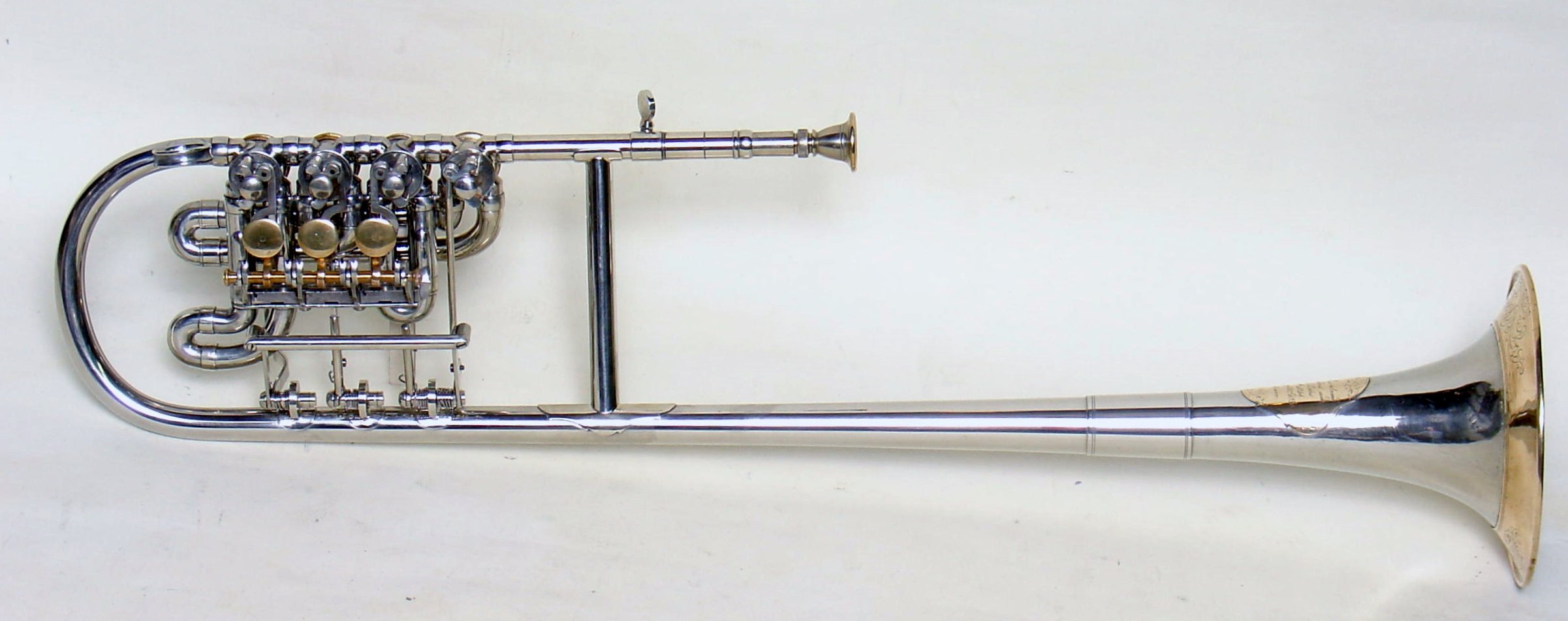Cornet in Eb and Bb by C.H. Eisenbrandt, Baltimore 1858
This Eb cornet with bell front and side action valve levers as pictured below has been well known to collectors of American brass instruments for many years because it had appeared in Mark Elrod and Robert Garafalo's book "A Pictorial History of the Civil War Era Musical Instruments and Military Bands".
Eisenbrandt Eb cornet as found.
The current owner, Alexander Pollock, contacted me and wanted it restored and informed me that not only had it originally had the bell over the shoulder, but it had contained the mechanism described in Eisenbrandt's US patent of January 26, 1858. This involves a fourth valve to change the pitch to Bb and a system of levers that adjust the three valve slide to compensate for the key change. I was skeptical, so he sent me the cornet. I examined it, and sure enough there was clear evidence that there had been a fourth valve and there were a few remnants of the mounts for the pull rod connections on the valve slides. It wasn't identical to the patent drawing in some minor details and I believe that it had been made after the patent had been granted.
Key change is made by pressing the horizontal bar with the left fingers.
It was also very clear that the extant curved tubing was not original, displaying very crude workmanship even though made of German silver that matched the original parts. I had a lot of research to do on this project. I found out that there were five or six other Eisenbrandt brass instruments known, so I contacted all of those owners. I learned that Eisenbrandt, a native of Germany who had established a music store in Baltimore in 1819, had developed a very close working relationship with Leopold Uhlmann of Vienna, Austria. Details of the known instruments show that they were indeed made in that shop. In his “Das Ventilblasinstrument”, Herbert Heide included mechanical drawings of Uhlmann’s valve mechanism from that time and they are a perfect match.
Herbert Heide’s drawing of Uhlmann’s mechanism match with those in Eisenbrandt’s instruments.
All of the known Eisenbrandt instruments are made of German silver with gold brass trim and have the bell over the shoulder but none of them have the fourth valve or key change mechanism, so I was stuck using the "sketchy" patent as my only guide for recreating it.
The only other Eb cornets that I could find were in the Vienna Kunsthistorisches Museum having never been sent to the US, although do have the large gold brass name shield with Eisenbrandt’s name as seen on this instrument. Interestingly, two other known instruments by Eisenbrandt, a Bb cornet and an Eb alto horn, are still owned by descendants of CH Eisenbrandt. Happily, the two instruments in Austria are Eb cornets of the same size as this, so getting the details of the bell curve and large bell brace was made much easier.
An interesting feature of Uhlmann’s valve mechanism is the two needle springs for each lever.
I was able to determine, mathematically, that it was impossible to have the mechanism pull out the second and third valve slides far enough to compensate for the key change to Bb so I must conclude that the maker considered it an acceptable compromise to pull them out as far as possible. In practice, I would say that the instrument is playable in both Eb and Bb but I'm also quite sure that no good player would be very happy with the second and third valve notes being as sharp in pitch as they are.
You can study the patent yourself and judge how well I made the mechanism. Here is an interesting quote from the patent specifications revealing some terminology of the day (1858): "it is an Eb soprano Saxhorn, and in its convertibility it becomes a Bb cornopean."
The balance of the restoration was also somewhat complicated as can be seen in the close up of the broken bell and valve casing knuckles. I could have disguised the new bell curve if I had silver soldered the bell to it, but I would have had to cut away a significant piece of ragged original metal.
In an extremely rare, one of a kind instrument such as this, it is more important to preserve every original bit possible. For the valve knuckles, I had to attach new curved tubes to a flange to solder to the casings, which makes the repairs visible but not obtrusive. The large bell brace and tuning mouthpipe were copied as best I could from the museum photographs.
There are other instruments with bell over the shoulder that were later remodeled to have the bell front. Two by J.L. Allen are featured on another page on this site.







